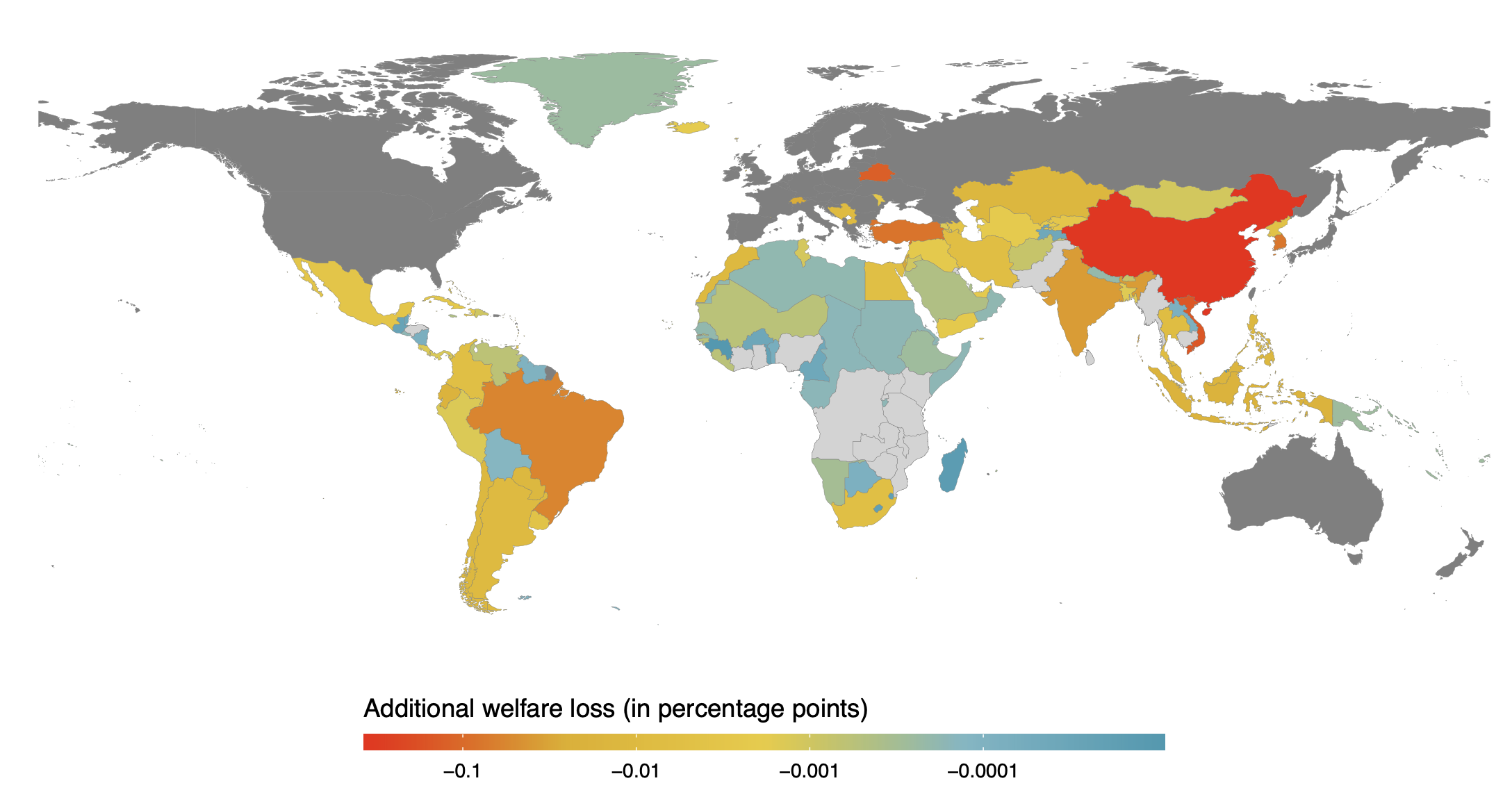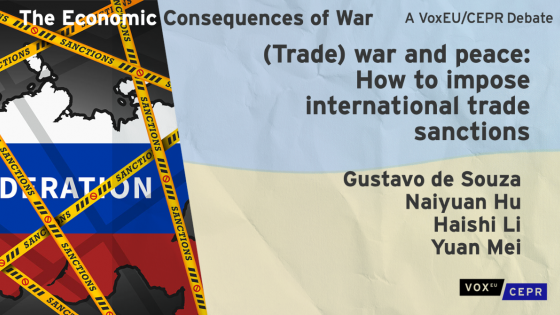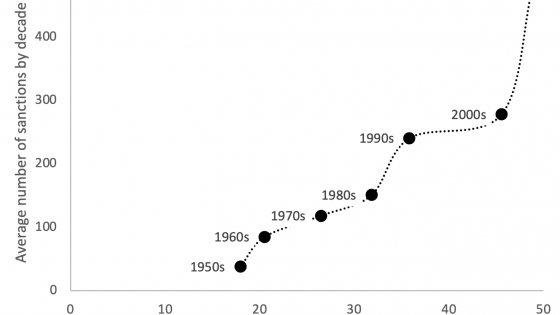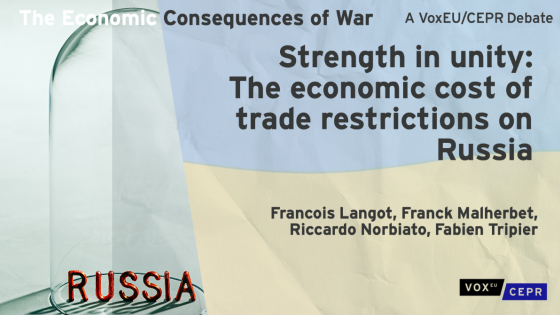The use of sanctions for the pursuit of geopolitical objectives has been rapidly rising since the 1970s, but most strikingly in the last decade (van Bergeijk 2022). The economic cost and coercive force of this instrument, however, relies upon countries’ positions in global trade networks. In a recent paper (Chowdhry et al. 2022), we quantify such costs and the deterrent potential of sanctions, and provide novel quantitative evidence on how they are affected by coalitions, i.e. alliances of countries that jointly implement sanctions.
Our analysis focuses on the wave of sanctions enacted against Iran in 2012 and Russia in 2014, as both episodes involved multiple sanction-sending countries that adopted restrictive measures which were unprecedented in terms of their severity at the time. In doing so, we contribute to the existing literature on the economic implications of sanctions, such as on the impact on prices and welfare in the target country, trade flows, poverty, as well as exchange rates. Our analysis also adds to more recent papers that focus on trade-offs in sanctions policy.
Our econometric methodology relies upon the structural gravity model, which we use to quantify the impact of sanctions on trade costs. These gravity estimations reveal that sanctions raised trade costs across a broad range of industries, particularly in agri-food products, electronic goods, wearing apparel, gas and coal. These sectoral trade cost estimates inform our general equilibrium simulations in the next step. The simulations here are based on a multi-country, multi-sector-style quantitative trade model that features rich input-output linkages. While the model generates many outcomes of interest, we focus on changes in aggregate welfare that are interpreted as the economic cost of sanctions.
Benchmarks
Following this approach, we first quantify the welfare costs of sanctions under the current coalition and three benchmark scenarios: (1) a ‘horizontal sanctions potential’ under which sanctions expand to a global coalition enforcing the current set of measures; (2) a ‘vertical sanctions potential’ under which the current coalition moves to a complete embargo; and (3) the autarky scenario where a global coalition places a complete embargo on trade with Iran or Russia. Table 1 displays the results of this exercise. Altogether, our simulations show that the current coalition against Iran enforces 63.8% of the welfare loss that can be realised by a horizontal expansion of sanctions and 37.4% of the welfare loss under a vertical expansion, while the respective shares for Russia are 57.9% and 32.5%.
Table 1 Benchmark impact for actual and hypothetical coalitions and measures
Note: The table above displays welfare losses imposed on Iran and Russia under different scenarios. Note that bootstrapped standard errors based on 1000 replications can only be computed for (i) and (ii) as there is no uncertainty in trade cost changes for (iii) and (iv).
Individual contributions: Welfare losses incurred and imposed
We next examine contributions of coalition members towards sanctions regimes by computing (1) the domestic welfare loss experienced from implementing sanctions; and (2) the welfare loss imposed on the target economy. The value of coordinating sanctions packages through coalitions is then ascertained by comparing these contributions under different scenarios where sanctions are either applied unilaterally or multilaterally. In the unilateral case, we examine welfare losses when moving from a baseline (with no sanctions) to a series of counterfactuals where each member of the current coalition independently imposes sanctions on Russia or Iran. In the multilateral case, we quantify changes in welfare when a given country is the last member to join the coalition.
Simulation results reveal that coalition members’ average domestic welfare loss is nearly 8.3% lower for Iran sanctions and 9.6% for Russia sanctions when these measures are enacted multilaterally instead of unilaterally. Additionally, coordinating sanctions magnifies their punitive force as welfare losses increase by 4.5% for Iran and 9.3% for Russia. Hence coalitions have the twin advantage of not only lowering the average domestic welfare loss faced by its members but also escalating the imposed welfare loss for sanctioned states.
How do contributions vary across coalition members? Figure 1 displays this heterogeneity for Russian sanctions and reveals that coalition members differ with regards to their effectiveness.
While larger economies like the US, Japan, and Germany are most effective in imposing sanctions in terms of welfare cost borne at home vis-à-vis welfare loss imposed on the target, smaller nations such as Malta, Estonia, and Latvia incur relatively high costs of sanctions that translate only into marginal welfare loss for Russia.
Figure 1 Incurred and imposed welfare costs of the 2014 Russia sanctions
Note: Figures above display each country in the current sanctions coalition against Russia and the welfare change it experiences domestically and which it imposes on the sanctioned state. The 95% confidence intervals on welfare losses are constructed from 1000 bootstrap replications of the simulations.
Prospective coalition partners
Next, we examine which third-party countries would need to join the coalition in order to make sanctions more costly for targeted nations. We do so by comparing welfare loss imposed under the current coalition and under an expanded coalition which includes one additional third-party country (see Figure 3). Focusing again on Russia sanctions, the leading partners which would raise the welfare loss imposed by the coalition on Russia are China (-0.37%), Vietnam (-0.15%), Belarus (-0.13%), Turkey (-0.08%), and South Korea (-0.08%). China’s membership in particular allows for closer fulfilment of the horizontal sanction potential, from 58% under the current coalition to 71%.
Figure 2 New coalition partners: Welfare loss imposed on Russia
Note: The map above displays the additional welfare loss incurred by Russia from each new country joining the current sanctions coalition. Countries which already sanction Russia are depicted in dark grey whereas countries in light grey correspond to those, whose membership in the coalition causes Russian welfare loss to marginally reduce.
Burden sharing
Given the uneven economic costs of implementing sanctions (as seen in Figure 1), we next examine the potential for a burden-sharing mechanism within the coalition. We do so by extending the model and incorporating a transfer mechanism that equalises aggregate welfare losses from sanctions across coalition members. Our results show that US$591 million and $4.8 billion would need to be mobilised for members to equalise their welfare loss from the Iran and Russia sanctions, respectively. The top contributor to these adjustment funds is the US, whose combined transfers for both sanction regimes would amount to approximately $3.13 billion. Combining both sanctions regimes, other top transfer-sending states are UK ($586 million), Canada ($446 million), Australia ($348 million) and Norway ($165 million).
Several Baltic states that incur relatively heavy domestic welfare losses from Russia sanctions receive transfers that are significant in terms of the shares of their GDP, e.g. Lithuania (0.64%), Estonia (0.37%), Latvia (0.28%), Ukraine (0.3%) and Slovakia (0.22%). While such direct compensations of sanctions-induced economic costs are likely difficult to be institutionalised, the hypothetical relative transfers can be seen as a sanctions equivalent of NATO spending goals.
Overall, our results underscore the asymmetries in the economic cost of implementing sanctions as well as the importance of building sanction coalitions. Furthermore, our analysis on hypothetical transfers provides an additional measure for the relative burden borne by participating coalition countries.
References
Caliendo, L and F Parro (2015), “Estimates of the Trade and Welfare Effects of NAFTA,” Review of Economic Studies 82(1): 1–44.
Chowdhry, S, J Hinz, K Kamin, and J Wanner (2022), “Brothers in Arms: The Value of Coalitions in Sanctions Regimes,” Kiel Working Paper 2234, Kiel Institute for the World Economy.
Crozet, M and J Hinz (2020), “Friendly Fire: The Trade Impact of the Russia Sanctions and Counter-Sanctions,” Economic Policy 35(101): 97–146.
de Souza, G, N Hu, H Li, and Y Mei (2022), “(Trade) war and peace: How to impose international trade sanctions,” VoxEU.org, 5 September.
Farrell, H and A L Newman (2019), “Weaponized interdependence: How global economic networks shape state coercion,” International Security 44(1): 42–79.
Head, K and T Mayer (2014), “Gravity Equations: Workhorse, Toolkit, and Cookbook,” in G Gopinath, E Helpman, and K Rogoff (eds), Handbook of International Economics, Volume 4 (4th edition), North Holland.
Heilmann, K (2016), “Does political conflict hurt trade? Evidence from consumer boycotts,” Journal of International Economics 99(C): 179–191.
Hinz, J and E Monastyrenko (2022), “Bearing the cost of politics: consumer prices and welfare in Russia,” Journal of International Economics, p. 103581.
Itskhoki, O and D Mukhin (2022), “Sanctions and the exchange rate,” VoxEU.org column, 16 May.
Langot, F, F Malherbet, R Norbiato, and F Tripler (2022), “Strength in unity: The economic cost of trade restrictions on Russia,” VoxEU column, 22 April.
Mahlstein, K, C McDaniel, S Schropp, and M Tsigas (2022), “Estimating the economic effects of sanctions on Russia: An allied trade embargo,” The World Economy.
Neuenkirch, M and F Neumeier (2016), “The impact of US sanctions on poverty,” Journal of Development Economics 121: 110–119.
Schropp, S and M E Tsigas (2022), “Designing ’optimal’ sanctions on Russian imports,” Robert Schuman Centre for Advanced Studies Research Paper No. RSC 45.
van Bergeijk, P A G (2022), “The second sanction wave”, VoxEU.org, 5 January.










